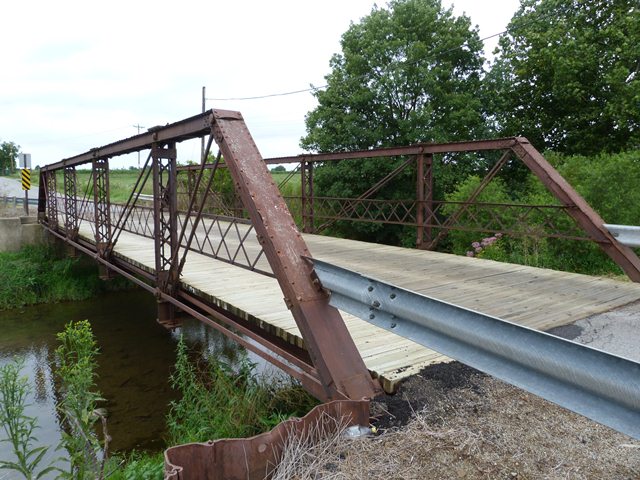We Recommend:
Bach Steel - Experts at historic truss bridge restoration.
BridgeHunter.com Phase 1 is released to the public! - Visit Now
Dailey Road Bridge

Primary Photographer(s): Nathan Holth
Bridge Documented: August 11, 2012
Rural: Morrow County, Ohio: United States
By Builder/Contractor: Unknown
2000
68.0 Feet (20.7 Meters)
69.0 Feet (21 Meters)
16 Feet (4.88 Meters)
1 Main Span(s)
5932157

View Information About HSR Ratings
Bridge Documentation
This bridge no longer exists!
Bridge Status: Demolished and replaced.View Archived National Bridge Inventory Report - Has Additional Details and Evaluation
This bridge is a pin-connected pony truss of moderate length. The bridge remains open to traffic. Its historic integrity is fair, however several alterations do exist. A retrofit is present: additional rods have been added at the vertical members. The bottom chord has some welded repairs and splices. Welded repairs are also found at the base of the end posts. The bridge uses recessed nuts for the pins on the bridge, which provide the benefits of both a washer and a nut in one unit. One of the bottom chord nuts was put on backwards, likely after some repair was made to the bridge. It looks quite silly to anyone who knows how it is supposed to look!
Despite alteration, the bridge continues to offer aesthetic qualities typical of a pin-connected truss bridge, those qualities being far superior to any modern bridge.
Information and Findings From Ohio's Historic Bridge InventorySetting/Context The bridge carries a 1 lane road over a stream in a rural area of active farms. The road narrows at the bridge. Physical Description The 1 span, 61'-long, pin-connected Pratt pony truss bridge is supported on ashlar abutments. The truss lines are traditionally composed with built up box sections for the upper chords and inclined end posts. The verticals are toe-out channels with lacing, and the diagonals and lower chords are eye bars. Vertical rod helpers have been placed, and there is impacted rust at the box sections. Integrity Numerous welded repairs, including the lower portions of all end posts. Vertical helpers added. Impacted rust. Summary of Significance The date of construction of the ca. 1888 pin connected Pratt pony truss bridge is not documented in Morrow County records, but stylistically it appears to have been fabricated by the Massillon Bridge Co. It is
one of 20 examples of the important bridge type in Morrow County with the oldest extant example dating to 1874. Many are undocumented and represent the era of standardization. This example is attributed to the, who sold many truss
bridges to the county. Morrow County retains many deteriorating pin connected truss bridges largely because of the economic issues associated with there replacement in a largely rural county with no industrial tax base. This example
is not historically or technologically significant. This example has expedient repairs and is not historically or technologically significant in comparison to the county and state population of pin connected pony truss bridges. Bridge Considered Historic By Survey: No |
![]()
Photo Galleries and Videos: Dailey Road Bridge
Bridge Photo-Documentation
Original / Full Size PhotosA collection of overview and detail photos. This gallery offers photos in the highest available resolution and file size in a touch-friendly popup viewer.
Alternatively, Browse Without Using Viewer
![]()
Bridge Photo-Documentation
Mobile Optimized PhotosA collection of overview and detail photos. This gallery features data-friendly, fast-loading photos in a touch-friendly popup viewer.
Alternatively, Browse Without Using Viewer
![]()
Maps and Links: Dailey Road Bridge
This historic bridge has been demolished. This map is shown for reference purposes only.
Coordinates (Latitude, Longitude):
Search For Additional Bridge Listings:
Bridgehunter.com: View listed bridges within 0.5 miles (0.8 kilometers) of this bridge.
Bridgehunter.com: View listed bridges within 10 miles (16 kilometers) of this bridge.
Additional Maps:
Google Streetview (If Available)
GeoHack (Additional Links and Coordinates)
Apple Maps (Via DuckDuckGo Search)
Apple Maps (Apple devices only)
Android: Open Location In Your Map or GPS App
Flickr Gallery (Find Nearby Photos)
Wikimedia Commons (Find Nearby Photos)
Directions Via Sygic For Android
Directions Via Sygic For iOS and Android Dolphin Browser
USGS National Map (United States Only)
Historical USGS Topo Maps (United States Only)
Historic Aerials (United States Only)
CalTopo Maps (United States Only)

